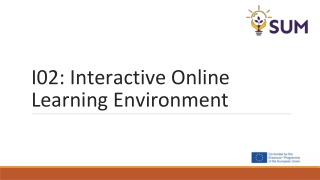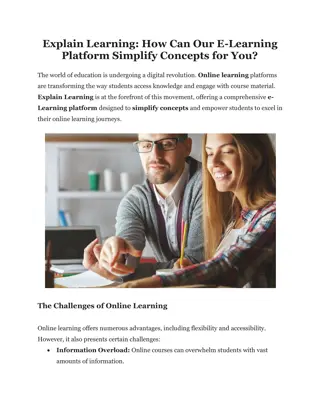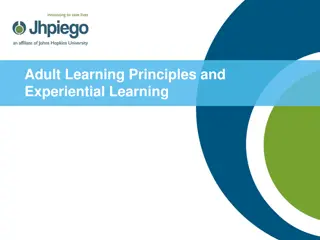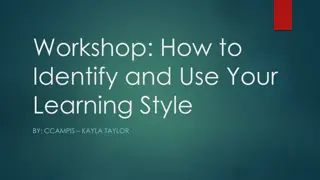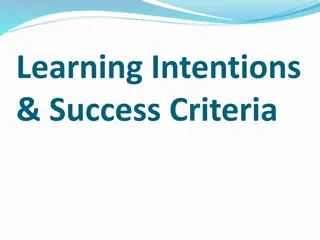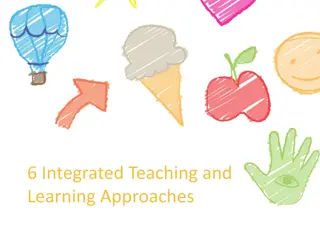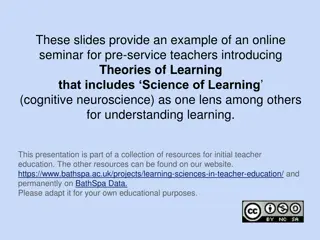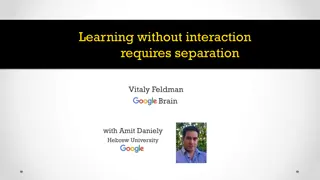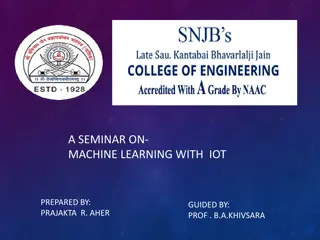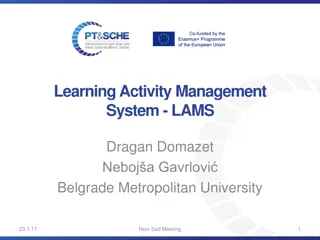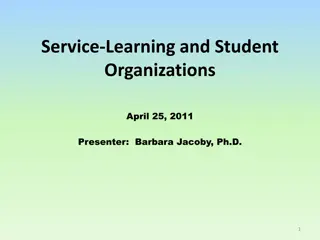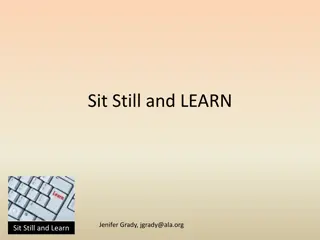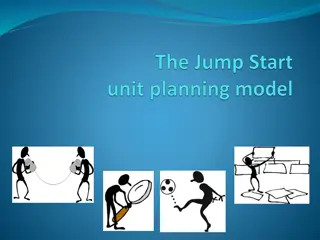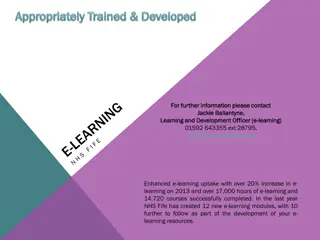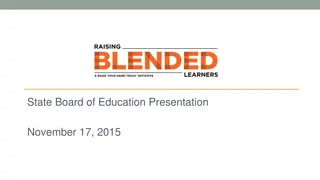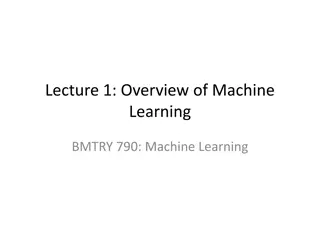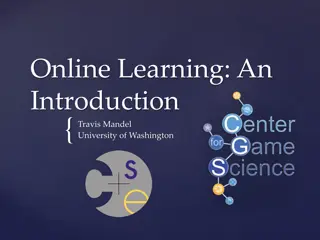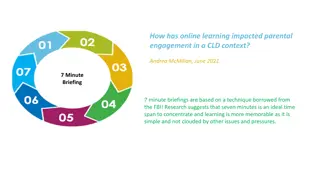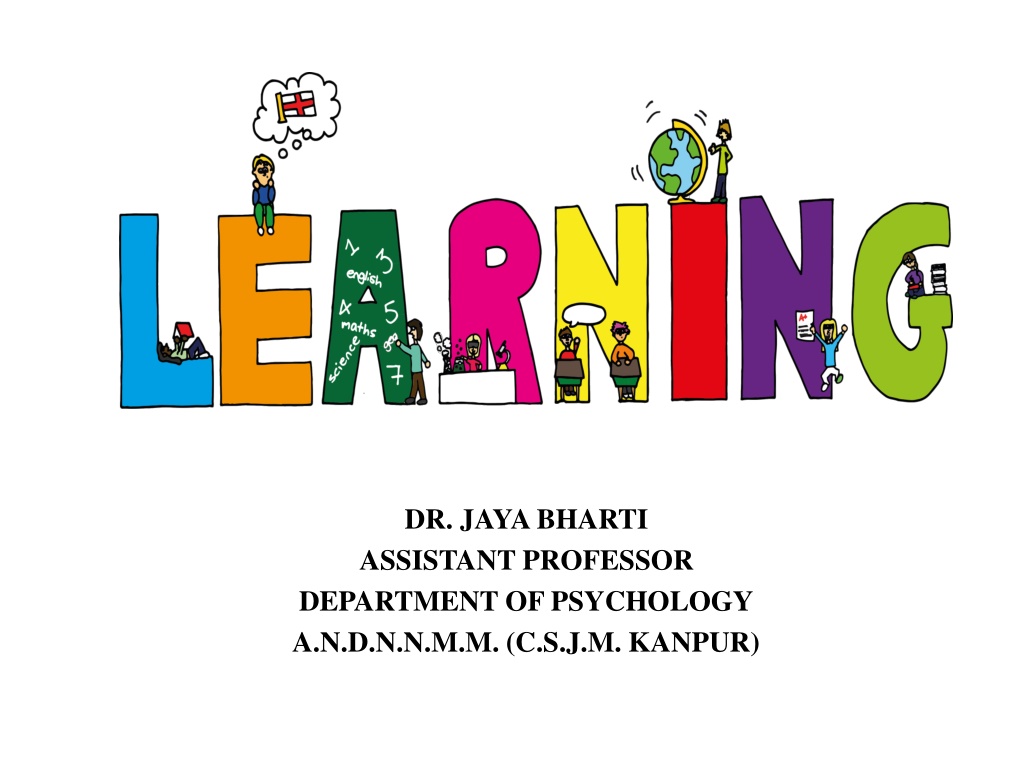
Understanding the Concept of Learning in Psychology
Learn about the concept of learning in psychology, including the process, characteristics, and classical conditioning. Explore how learning shapes behavior and facilitates adaptation through experiences and practice.
Download Presentation

Please find below an Image/Link to download the presentation.
The content on the website is provided AS IS for your information and personal use only. It may not be sold, licensed, or shared on other websites without obtaining consent from the author. If you encounter any issues during the download, it is possible that the publisher has removed the file from their server.
You are allowed to download the files provided on this website for personal or commercial use, subject to the condition that they are used lawfully. All files are the property of their respective owners.
The content on the website is provided AS IS for your information and personal use only. It may not be sold, licensed, or shared on other websites without obtaining consent from the author.
E N D
Presentation Transcript
DR. JAYA BHARTI ASSISTANT PROFESSOR DEPARTMENT OF PSYCHOLOGY A.N.D.N.N.M.M. (C.S.J.M. KANPUR)
CONCEPT OF LEARNING Learning, in psychology, the process by which a relatively lasting change in potential behaviour occurs because of practice or experience. Learning is also a process of acquiring modifications in existing knowledge, skills, habits, or tendencies through experience, practice, or exercise.
Learning is the process of progressive behaviour adaptation. -Skinner Learning is the acquisition of new behaviour or strengthening or weakening of old behaviour as a result of experience . -Henry, P Smith Learning is the process of progressive behaviour adaptation . - Skinner Learning is the acquisition of habits, knowledge and attitudes. It involves new ways of doing things, and it operates in an individual s attempt to overcome obstacles or to adjust to new situations . -Crow and Crow Learning is the modification of behaviour through experience . - Gates and others
CHARACTERISTICS OF LEARNING Learning is a continuous modification of behaviour which continues throughout life Learning is pervasive. It reaches into all aspects of human life. Learning involves the whole person, socially, emotionally & intellectually. Learning is often a change in the organisation of behaviour. Learning is development. Time is one of its dimensions. Learning is responsive to incentives. In most cases positive incentives such as rewards are most effective than negative incentives such as punishments. Learning is always concerned with goals. These goals can be expressed in terms of observable behaviour. Interest & learning are positively related. The individual learns best those things, which he is interested in learning. Most boys find learning to play football easier than learning to add fractions. Learning depends on maturation and motivation.
CLASSICAL CONDITIONING Ivan Pavlov (1849-1936) . Pavlov was a Russian physiologist who was doing research on digestion. His research was aimed at better understanding the digestive patterns in dogs. Later on, the dogs began to salivate as soon as the person feeding them would enter the room. Then he moved his focus to Classical Conditioning. Learning to associate an unconditioned stimulus that already brings about a particular response with a new stimulus, so that the new stimulus brings about the same response. In simple terms two stimuli are linked together to produce a new learned response in a person or animal. The first systematic study of basic laws of learning and or conditioning. Involves placing a neutral signal before a reflex . Focuses on involuntary, automatic behaviours.
Classical conditioning is a form of learning whereby a conditioned stimulus (CS) becomes associated with an unrelated unconditioned stimulus to produce a behavioral response known as a conditioned response (CR). The conditioned response is the learned response to the previously neutral stimulus. The unconditioned stimulus is usually a biologically significant stimulus such as food or pain that elicits an unconditioned response (UR) from the start. The conditioned stimulus is usually neutral and produces no particular response at first, but after conditioning it elicits the conditioned response. (US), in order
He inserted a small test tube into the cheek of each dog to measure saliva when the dogs were fed (with a powder made from meat). Pavlov predicted the dogs would salivate in response to the food placed in front of them, but he noticed that his dogs would begin to salivate whenever they heard the footsteps of his assistant who was bringing them the food. When Pavlov discovered that any object or event which the dogs learned to associate with food (such as the lab assistant) would trigger the same response, he realized that he had made an important scientific discovery. Accordingly, he devoted the rest of his career to studying this type of learning.
COMPONENTS OF CLASSICAL CONDITIONING The Unconditioned Stimulus (UCS) :A stimulus that automatically triggers a response. naturally, and The unlearned response that occurs naturally in response to the unconditioned stimulus. Unconditioned Response(UCR):The The Conditioned Stimulus(CS):A previously neutral stimulus that when paired with an unconditioned stimulus triggers a conditioned response. + The response to the previously neutral stimulus. Conditioned Response(CR):Learned
TYPES OF CONDITIONING Forward Conditioning- Occurs when the neutral stimulus (NS) appears just before and during the presentation of the unconditioned stimulus (UCS). UCS C.S. There are 2 types: 1. Delayed conditioning (forward) - the CS is presented before the US and it (CS) stays on until the US is presented. This is generally the best, especially when the delay is short. C.S. UCS 2. Trace conditioning - discrete event is presented, then the US occurs. Shorter the interval the better, but as you can tell, this approach is not very effective.
Backward conditioning Backward conditioning occurs when a Conditioned stimulus immediately Unconditioned stimulus. follows a Temporal Unconditioned presented at regular intervals, for instance every 10 minutes conditioning stimulus a is CS UCS Simultaneous conditioning - Both conditioned unconditioned stimulus occurs and terminates at same time. and
Instrumental conditioning is another term for Operant Conditioning, a learning process first described by B. F. Skinner. In instrumental conditioning, reinforcement or punishment are used to either increase or decrease the probability that a behaviour will occur again in the future.
A method of learning that occurs through reinforcements punishments for behavior. We learn to perform certain behaviors more often because they result in rewards, and learn to avoid other behaviors because they result in punishment consequences. and or adverse
In a typical experiment, a rat or pigeon would be put into the Skinner box in which temperature, light and noise could be kept constant. On one wall of the box, there would be a lever and a hopper that could deliver a food pellet to the animal when the lever was pressed. Initially, the rat is likely to wander around the box aimlessly until it accidentally presses the lever and receives a food pellet. Skinner would leave the animal in the box and measure how frequently the animal pressed the lever over time. The frequency should indicate the strength of the conditioning of the behaviour. This would then be repeated with other animals.
REINFORCEMENT IN INSTRUMENTAL CONDITIONING

